Rubber Roof Installers Near Me: Quality and Affordable Services at ID Flat Roof
Reading Time: 11 minutesNeed reliable rubber roof installers near me? This guide helps you find experts in top-notch rubber roofing. Learn about the benefits, types of materials, and how to choose the right contractor. Local roofing companies can provide reliable services to meet your needs. Let’s begin!
Free Estimates and Consultations at ID Flat Roof
Beginning your roofing project with free estimates and a roofing consultation can set the proper foundation. Many roofing contractors offer these services to help property owners plan and budget their projects effectively. Utilizing free estimates allows homeowners to compare costs between contractors, ensuring they get a fair price for the services. It also provides a clearer picture of the project, helping homeowners make informed decisions about their roofing needs.
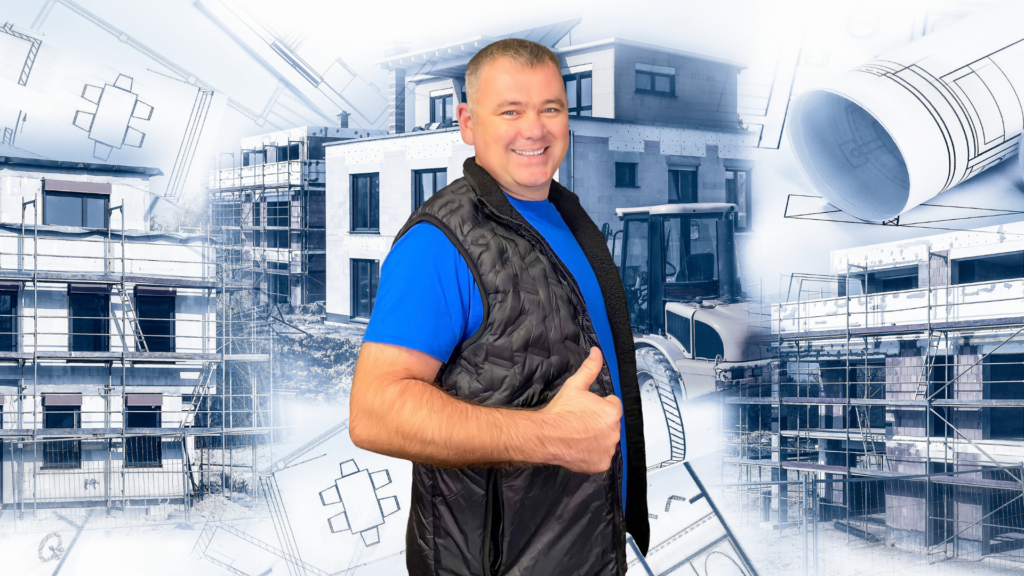
Free consultations are equally valuable, as they assist homeowners in understanding the best roofing options available for their specific needs and conditions. During these consultations, contractors can inspect the roof, identify potential issues, and recommend the most suitable materials and installation methods. This personalized advice ensures that the roofing solution chosen is optimal for the property’s unique requirements.
At ID Flat Roof, we offer:
- Free estimates and consultations to help you get started with your roofing project
- A team of experienced professionals dedicated to providing cost-effective solutions
- Services that meet your needs and exceed your expectations
- Durable, high-quality rubber roofs
Contact us today to schedule your free consultation and take the first step towards a durable, high-quality rubber roof.
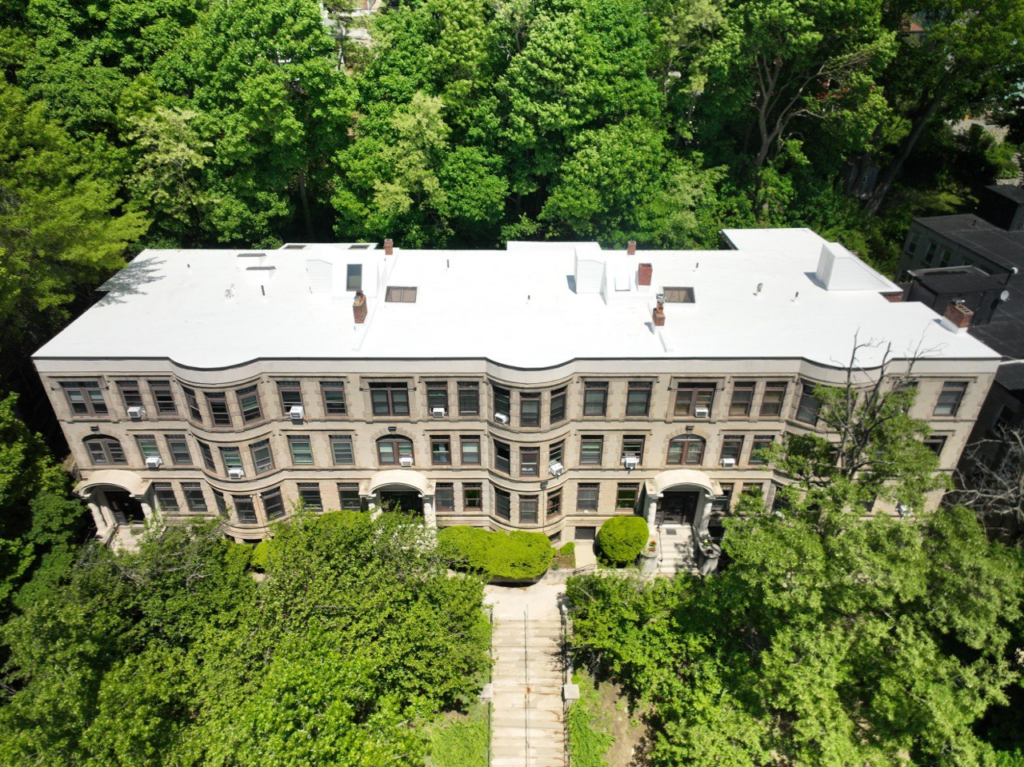
Key Takeaways
- Rubber roofing is highly durable, energy-efficient, and environmentally friendly, making it a top choice for commercial and residential properties.
- There are three main types of rubber roofing materials: EPDM, TPO, and PVC. Each offers unique benefits and suitability for different roofing needs, providing versatile solutions for various applications.
- Hiring professional rubber roof installers ensures high-quality craftsmanship, longevity, and comprehensive warranties, providing property owners with peace of mind and enduring protection.
Why Choose Rubber Roofing?
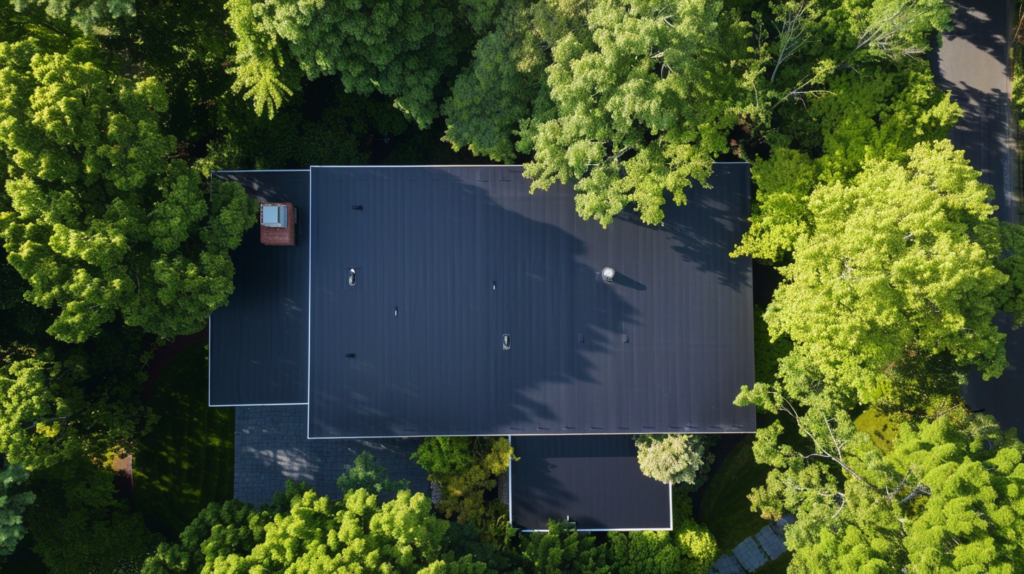
Rubber roofing is celebrated for its long-term durability, with rubber roofs often lasting 40 years or more. This exceptional lifespan is thanks to the material’s resistance to a wide array of environmental factors, including:
- UV radiation
- fire
- pests
- mold
- mildew
One key contributor to rubber roofs’ longevity is their weather resistance, which allows them to withstand various environmental conditions effectively.
Furthermore, rubber roofs are incredibly lightweight, making installation and transporting them more accessible and cost-effective. Whether you’re looking for a new roof for a commercial or residential building, rubber roofing is an ideal choice due to its superior durability and low maintenance requirements.
Energy efficiency is another crucial advantage of rubber roofing. These roofs provide excellent insulation, helping to block heat and reduce energy costs. This makes rubber roofing an eco-friendly option that protects your property and contributes to a greener planet. Rubber roof installers design systems to adapt to the building’s shape changes, ensuring a tight seal that minimizes leaks and maintains structural integrity over time. With fewer gaps in the material, rubber roofs are less prone to leaks, providing an extra layer of security for your property.
Rubber roofing offers several benefits, including:
- Adaptability to various weather conditions, including extreme temperatures and heavy rainfall
- Suitability for low slope roofs, where traditional roofing materials might fail
- Low maintenance needs, typically just twice-a-year checks
- Durability and hassle-free installation
With all these benefits, it’s no wonder that more and more property owners are turning to rubber roofing for their roofing projects.
Types of Rubber Roofing Materials



Three central roofing membranes should be considered regarding rubber roofing materials: EPDM, TPO, and PVC. Each of these materials has unique benefits and is suitable for different roofing needs.
EPDM, or ethylene propylene diene monomer, is a thermoplastic polymer known for its flexibility, chemical resistance, and excellent dielectric qualities. It is commonly used on low-slope flat roofs and is a popular choice for an EPDM roof system due to its durability and non-toxic nature. EPDM roofs come in various colors, including black, white, gray, and tan, allowing for customization based on aesthetic preferences and functional requirements. Rubber roof installers prefer EPDM for its reliable performance and adaptability to different roofing needs.
TPO, or thermoplastic polyolefin, is highly durable and resistant to:
- UV radiation
- rain
- snow
- hail
Due to its excellent thermal reflectivity, TPO is known as a cool roof’ and is particularly popular in areas with harsh weather conditions. This roofing material is easy to install and provides excellent energy efficiency, making it a cost-effective solution for many property owners.
PVC, or polyvinyl chloride, is another thermoplastic polymer with superior resistance to chemicals, grease, and environmental factors. PVC membranes are highly durable, recyclable, and environmentally friendly, making them an excellent alternative to traditional felt roofing. They are especially recommended for areas prone to heavy rains, winds, and other severe weather conditions.
Property owners can choose the material that best fits their roofing needs and conditions with these three options.
Evaluating Rubber Roof Contractors
Selecting a competent rubber roofing contractor is crucial to achieving a high-quality installation and enduring results. Experience and certifications should be at the top of your checklist when evaluating potential rubber roofing contractors. These elements guarantee that the contractor has the necessary skills and knowledge to handle your roofing project effectively. Hiring licensed roofing contractors and verifying their credentials is crucial to ensure they meet industry standards. A contractor with a solid background in rubber roofing will be familiar with the best practices and latest technologies, providing a smooth and efficient installation process.
Another essential factor to consider is the contractor’s portfolio and customer feedback. Assessing past projects and reading customer reviews can provide valuable insights into the contractor’s reliability and the quality of their work. Positive feedback from previous clients indicates that the contractor delivers on their promises and maintains high standards. Additionally, a detailed roofing estimate is essential for understanding the costs involved and the materials that will be used. A comprehensive estimate should include the type and manufacturer of the materials, a breakdown of labor costs, and a detailed warranty for both materials and labor. Rubber roof installers often provide detailed portfolios and transparent estimates to ensure customer satisfaction and trust.
Discussing your specific roofing needs and goals with the contractor is also important. Whether you’re looking for energy efficiency, improved longevity, or aesthetic appeal, the contractor should be able to recommend the most suitable roofing system for your property. By evaluating these factors, you can ensure that you choose a reliable and experienced contractor who will deliver a high-quality rubber roof that meets your needs.
Cost of Rubber Roof Installation
Grasping the cost of rubber roof installation is vital to budgeting and planning your roofing project effectively. The national average installation costs for installing a rubber roof range between $9,000 and $18,000, depending on various factors such as the size of the roof, the type of material used, and labor costs. For instance, most homeowners spend around $15,000 to install and seal a 1,500 sq.ft mechanically attached TPO roof.
The cost of rubber roofing materials varies significantly. EPDM roofing installation costs range from $4.25 to $13 per sq. ft, making it a cost-effective option for many property owners. TPO roofing costs between $4.50 and $14 per sq. ft, while PVC roofing typically costs between $5.50 and $15 per sq. ft. These prices include material and labor costs. However, some contractors may itemize labor separately, with rates typically ranging between $2.50 and $11 per sq. ft. Roofers might charge an hourly rate of $45 to $75 per hour for specific tasks.
When planning for a new roof, it’s also essential to consider the potential costs of replacement over roofing over an existing structure. Roof replacement can cost between $2.50 to $8 per sq. ft. In contrast, a full replacement might be more costly, ranging from $3.50 to $9 per sq. ft. All these prices are approximate and can vary from state to state, so getting detailed estimates from multiple contractors is essential to ensure you’re getting a fair price. By getting familiar with these cost factors, you can confidently make decisions and efficiently budget for your rubber roof installation. Consulting with rubber roof installers can provide further clarity on costs and ensure a high-quality installation.
The Installation Process

The roofing installation method for a rubber roof is significant in its longevity and performance. The installation process includes the following steps:
- Preparation of the roof deck includes cleaning and smoothing the surface to ensure proper adhesion of the rubber membrane.
- Installing a drip batten helps to direct water away from the roof edges and prevent leaks.
- Applying adhesive to the roof deck.
- Rolling out the rubber membrane and pressing it into the adhesive.
- Trimming the excess rubber membrane.
- Sealing the seams and edges of the rubber membrane.
- Installing flashings and other accessories as needed.
By following these steps, you can ensure a proper and long-lasting rubber roof installation.
After preparing the roof deck, the rubber membrane should fully relax before application. This step is crucial for avoiding wrinkles and ensuring a tight fit. EPDM rubber roofs can be installed using three primary methods:
- Adhered: adhesive is applied to the deck before laying the EPDM membrane, ensuring a solid bond. Contact adhesive around the roof perimeter must be touched dry before proceeding.
- Mechanically fastened: the EPDM membrane is secured to the roof deck using mechanical fasteners, such as screws or nails. This method provides added stability and is often used in high wind or seismic activity areas.
- Ballasted: the EPDM membrane is laid loosely over the roof deck and then weighted down with ballast, such as gravel or pavers. This method is often used on flat roofs and provides excellent insulation and protection against UV rays.
Each method offers its benefits and considerations, so choosing the right one for your specific project is essential.
The choice of installation method depends on various factors, including the roof’s structure and the project’s specific requirements. A well-executed installation process enhances the roof’s performance and extends its lifespan.
Maintenance Tips for Rubber Roofs

Consistent upkeep can extend a rubber roof’s lifespan and prevent potential problems. Here are some tips for maintaining your rubber roof:
- Regular inspections are conducted twice yearly to identify early signs of damage, such as cracks, holes, and loose seams.
- Periodically visually check your roof for any necessary repair work before it becomes severe.
- Inspect for blisters, which can occur from trapped moisture expanding in hotter climates.
Preventative maintenance can significantly extend the lifespan of a rubber roof by addressing issues before they become significant problems.
By following these maintenance tips, you can keep your rubber roof in good condition and avoid costly repair services in the future.
Keeping the roof clean is another crucial aspect of maintenance. Here are some tips to help you keep your roof in good condition:
- Sweep the roof regularly to remove leaves, twigs, and debris to prevent safety hazards and water stagnation.
- Maintain and trim surrounding trees to reduce debris buildup on the roof, further protecting it from potential damage.
- Clean the rubber roof with dish soap and water using a soft or medium bristle brush.
Following these tips will help you maintain a clean and well-maintained roof.
Rubber roof coatings can extend the roof’s lifespan by providing extra protection against UV rays and weathering. These coatings can also help seal minor cracks or splits, preventing leaks and further damage. Following these maintenance tips, property owners can ensure their rubber roofs remain in excellent condition for years.
Common Issues with Rubber Roofs and How to Fix Them
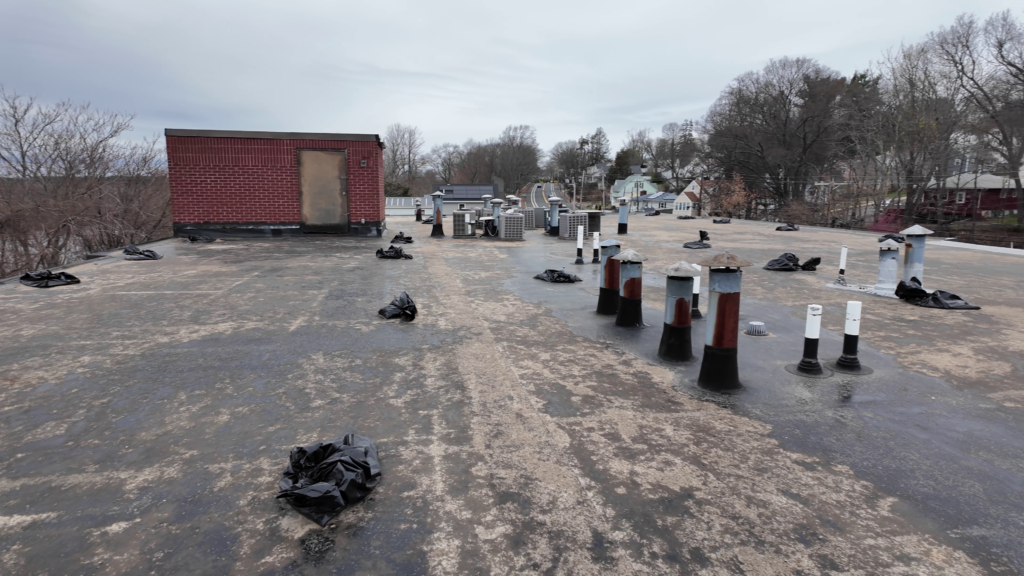
Despite rubber roofs’ known durability, they can still face problems requiring prompt roof repair. Leaks, for instance, can occur due to failed seams. Seam separation is often caused by weakening adhesive over time, resulting in gaps and potential leaks. Properly securing the flashing around roof edges, vents, and chimneys can prevent these issues.
Water ponding on flat rubber roofs is another common problem. This occurs when drainage isn’t efficient, causing increased pressure and potential leakage. Installing proper drainage systems can help mitigate this risk, effectively diverting water from the roof. Punctures and tears in rubber roofs are often caused by heavy foot traffic or overhanging branches. These can be repaired using a rubber roof patching kit to cover and seal the damaged areas.
Environmental factors such as pollution and biological growth, such as algae, can degrade rubber roofing material over time. Regular cleaning and applying protective coatings can slow this degradation. Surface wear and tear, including cracking and blistering, is often exacerbated by extreme weather conditions and UV exposure. Regular inspections and timely repairs can extend the roof’s life, ensuring it remains a reliable barrier against the elements.
Advantages of Hiring Professional Rubber Roof Installers
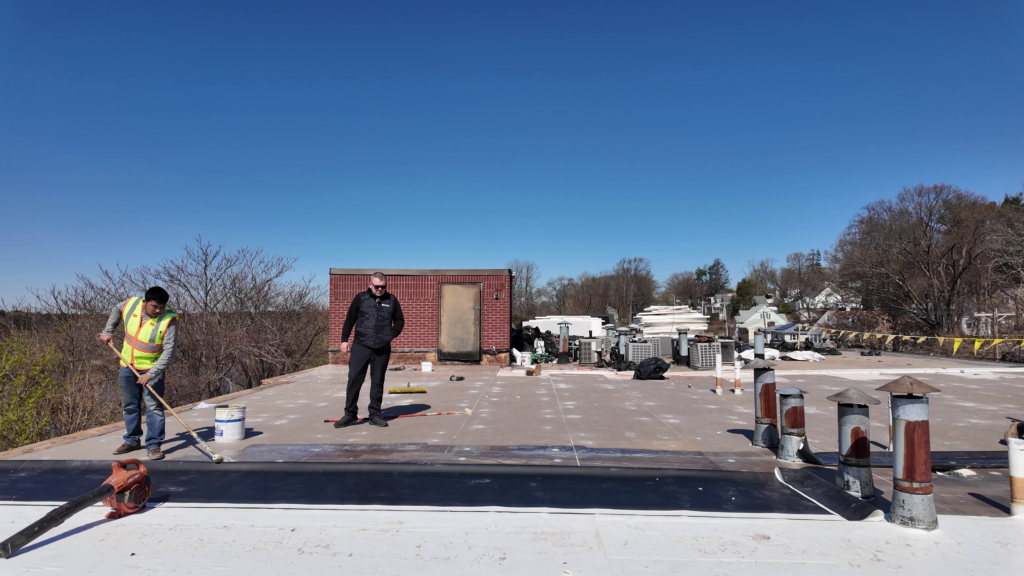
Engaging professional rubber roof installers brings many benefits, including:
- Assurance of a superior, durable roof system
- The craftsmanship that keeps buildings watertight protects properties and employees and provides peace of mind
- A Single-Source Warranty backed by a multi-million dollar provision
- Rubber roofing that moves with your building, maintaining a tight shield against the elements
Professional roofing services ensure a high-quality installation, providing a reliable and long-lasting roof.
Professionals bring expertise and experience to the table, leading to long-lasting roofs that can potentially last over 40 years. They are familiar with the best practices and latest technologies in rubber roofing, ensuring that the installation process is smooth and efficient. Moreover, professional installers can provide valuable advice on the most suitable roofing materials and systems for your specific needs, whether for a residential or commercial building.
Choosing professional installers also means you benefit from comprehensive warranties and reliable customer service. ID Flat Roof offers a manufacturer’s lifetime installation warranty and a 10-year workmanship warranty. This level of assurance is invaluable, as it guarantees that any issues will be addressed promptly and effectively, giving you confidence in the longevity and performance of your new roof.
Summary
Rubber roofing offers numerous benefits, including long-term durability, energy efficiency, and low maintenance requirements, making it an excellent option for roofing services. By choosing the right rubber roofing material and contractor, you can ensure a high-quality installation that protects your property and provides peace of mind. Professional installers bring expertise and comprehensive warranties, making them a worthwhile investment. Don’t forget to use free estimates and consultations to plan and budget your roofing project effectively. With ID Flat Roof, you’re assured of quality and affordability, making rubber roofing the ideal choice for your next roofing project.
Frequently Asked Questions
The main types of rubber roofing materials are EPDM, TPO, and PVC, each offering unique benefits and suitable for different roofing requirements. Exciting options for a durable and versatile roof!
Installing a rubber roof can cost between $9,000 and $18,000, ranging from $4.25 to $15 per square foot. It’s an investment in the long-term protection of your home!
Hiring professional rubber roof installers ensures a high-quality, long-lasting roof system, providing peace of mind through expert craftsmanship and comprehensive warranties. You can trust in their expertise for a durable and reliable result!
You should inspect and maintain your rubber roof twice yearly and clean it periodically to keep it in top shape and avoid potential problems. This will help extend its lifespan and save you from costly repairs!
Rubber roofs can have leaks, loose flashing, and punctures, but don’t worry! You can quickly fix them with timely repairs, good drainage, and regular maintenance. Follow these simple solutions to keep your rubber roof in top shape.
Denis is the driving force behind ID Flat Roof, a leading company in Boston specializing in flat roof repair and installation for over 20 years.
Expertise:
Denis excels in PVC, TPO, EPDM, and rubber roofing. His meticulous approach ensures quality and customer satisfaction.
Innovation:
Denis incorporates cutting-edge solutions like skylights and solar PV roofing.



